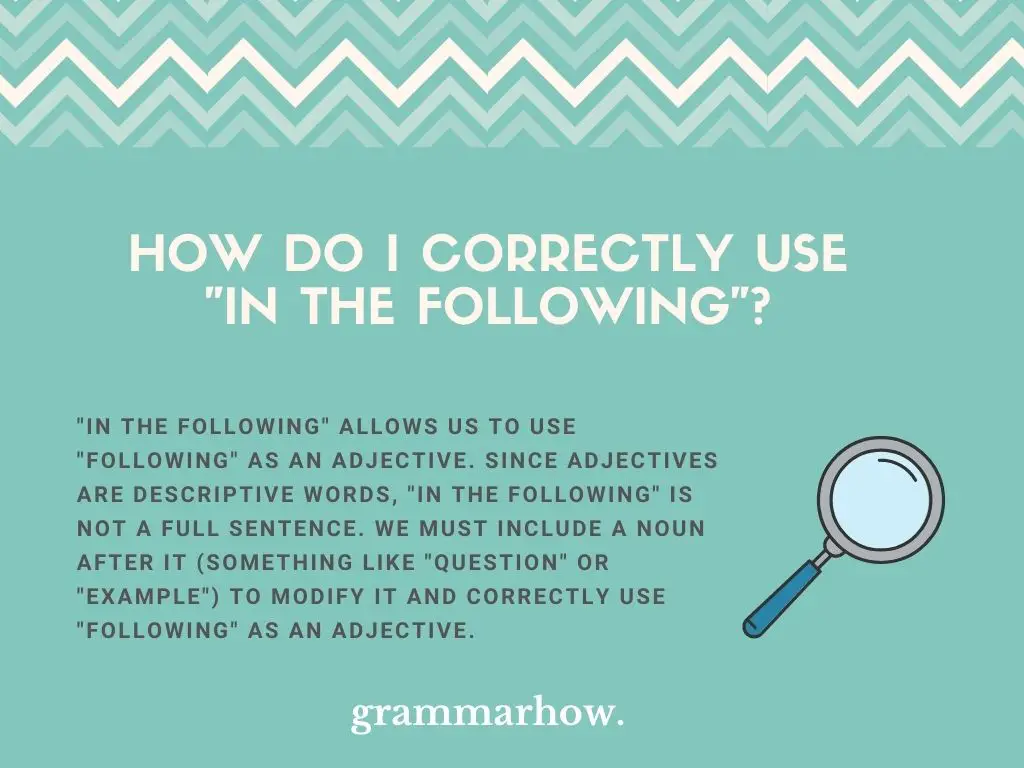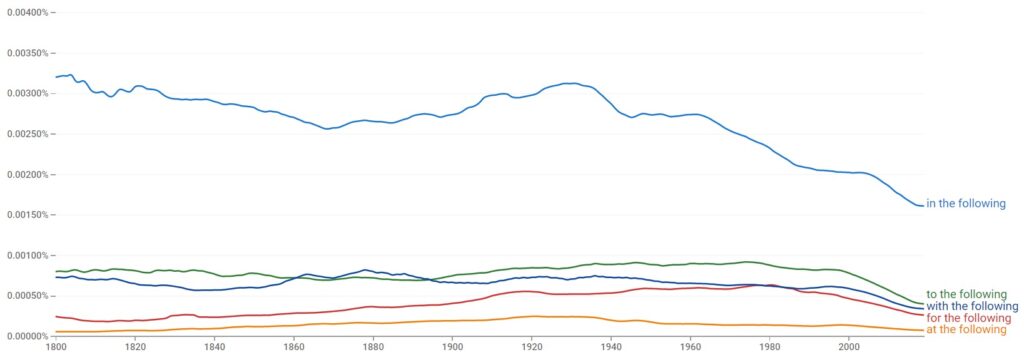“In the following” is an interesting phrasal form we can use in English. We can turn “following” into an adjective in this form, and the context allows us to modify certain nouns or structures based on what we’re writing about. This article will explore how it works.
How Do I Correctly Use “In The Following”?
“In the following” allows us to use “following” as an adjective. Since adjectives are descriptive words, “in the following” is not a full sentence. We must include a noun after it (something like “question” or “example”) to modify it and correctly use “following” as an adjective.

“In the following” means that we are referring to a subject that follows the sentence. It can be a question, example, or figure of some kind that might help to further explain something that we’re currently writing about.
Simply including “the” goes a long way when changing the form of “following.” Many people require a noun to follow it, and you might see something like the following:
- In the following examples, I want you to pay attention to what you see.
- In the following questions, you will be tested on what you’ve learned so far.
As you can see, a noun is required after “following” in most cases. The only time the noun is omitted is when it’s made clear what the noun should be from the context:
- You will learn more about that in the following (examples).
Can I Start A Sentence With “In The Following”?
It’s possible to start sentences with “in the following.” As a matter of fact, we’ve already done so in the previous section. Still, it would help to know more about it.
“In the following” is a dependent clause. As long as we complete the clause with another noun, we can place it at the beginning or the end of a sentence. If you do place it at the start, you must always include a comma after it.
The following two sentences are identical, but “in the following” changes place:
- You’ll learn more about it in the following examples.
- In the following examples, you’ll learn more about it.
Placing “in the following” at the start helps to establish your intention as the writer. You might want to show that the “examples” coming up are the most important pieces of information, so starting the sentence with it could be more beneficial than ending the sentence.
Examples Of How To Use “In The Following” In A Sentence
Perhaps you’d like to check out some more examples to see how you can use the phrase better.
- In the following examples, you’ll be exposed to some of the methods used in medieval history.
- You’ll have to learn more about these in the following examples so that you know what’s going to happen next.
- In the following situation, what would you be more likely to do? We need to know your honest answer to evaluate you.
- In the following figure, you’ll see the artwork in question. It’s a great piece to demonstrate his struggles as an artist.
- There are a few things in the following examples that I don’t agree with, but I’ll leave them up to you to interpret.
- We should discuss more about this in the following sections. It would help us both to understand what’s going on.
- In the following predicament, I had a hard time coming up with a feasible way to complete the experiment.
“In the following” works well when we are talking about a specific instance or example. “Following” is an adjective that means that something is going to follow our current sentence directly.
In most written cases, it’s likely that you’ll see it work like this:
- In the following examples, you’ll see what we mean:
- “List of following examples”
As you can see, it’s common for the noun to be the next thing after “in the following.” If we included it any later than that in our writing, then using “in the following” wouldn’t make any sense.
Is It “In The Following” Or “In Following”?
“In the following” is the only correct form. We use “the” to turn “following” into an adjective. This, in turn, helps us to modify the questions, examples, figures, or other ideas we’re talking about. “In following” is confused as a verb form, so it’s best not to use it.
“In The Following” – Synonyms
Perhaps you’d like a synonym for “in the following” to expand your vocabulary even more. The synonyms in the following list (do you see what we did there?) will work well for you:
- In the coming
- Coming up
- Next
- In what follows
- Subsequent
- As follows
- Moving forward
Which Other Prepositions Can Be Used Before “The Following”?
There are other prepositions to use with “the following.” “In” isn’t the only option. You might also find the following work well:
- To the following
- With the following
- For the following
- At the following
According to Google Ngram Viewer, “to the following” is the next most popular choice after “in the following.” “For, “with,” and “at” are used enough to be on the graph, which shows that all three prepositions are correct.

To The Following
“To the following” usually requires your attention or focus. “To” refers to you referring your attention toward the object in question.
- Pay attention to the following examples.
With The Following
“With the following” allows us to think about the “following” nouns. We can work “with” them to come up with a solution to a problem that might be posed to us.
- With the following questions in mind, how would you tackle this issue?
For The Following
“For the following” works best when you are being instructed to do something with a question, example, or figure. Questions are the most common with “for” since it allows you to focus your attention on answering them.
- You’ll need to prepare for the following questions.
At The Following
“At the following” is a simple directive command. We can use it when we want people to look “at” something in particular.
- Please look at the following examples.
You may also like:
